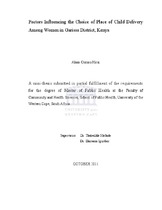| dc.description.abstract | Although the Kenyan government implemented safe motherhood programme two
decades ago, available data indicate that prevalence of home delivery is still high among
women in Garissa District. The aim of this thesis was to investigate the factors
influencing the choice of place of childbirth. Methodology: A descriptive cross-sectional
study was carried out among 224 women who delivered babies two years prior to
December 2010. Using a statcalc program in Epi Info 3.3.2, with expected frequency of
home delivery at 83% +5% and a 95% confidence level, the calculated sample size was
215. Furthermore, with a 95% response rate the adjusted minimum sample size was 226.There were two none-responses hence 224 women were interviewed. Stratified sampling was used. Data were collected using pre-tested structured questionnaires and analyzed using SPSS. Descriptive, bivariate and multivariate analysis was performed. A binary logistic regression analysis using the Enter method was performed to determine
independent predictors for use or non-use of healthcare services for childbirth. The
threshold for statistical significance was set at 0.05. Results: The result was presented in text and tables. The study found 67% (n=224) women delivered at home and 33%
delivered in hospital. The study found low level of education, poverty, none-attendance of ANC, distance, cost of services, poor quality services, negative attitude towards
midwives, experience of previous obstetric complications and decision-making to be
significant predictors in home delivery at the bivariate level (p<0.05). The study did not
find relationship between age, marital status, religion and place of childbirth (p>0.05). At multivariate level, the following variables were still found to be significant predictors of home delivery: no education OR=8.36 (95% CI; 4.12-17.17), no occupation
OR=1.43(95% CI; 1.08–5.49) experience of obstetric complications OR=1.38 (95% CI;
1.15-2.12), none-attendance of antenatal clinic OR=1.11 (95% CI; 1.03–1.51), Rude
midwives OR=5.60 (95% CI; 2.66-11.96). Conclusions: high prevalence of home
delivery was noted due to lack of education, poverty and inaccessible maternity services
hence the need to empower women in education and economy to enhance hospital
delivery. | en_US |

